Swallowing disorders, causes and solutions is the subject for today. Swallowing difficulty cause : Your thyroid is a gland found in your neck just below your Adam’s apple. A condition that increases the size of your thyroid is called a goiter. Read more about the causes and symptoms of goiter. Esophagitis: Esophagitis is inflammation of the esophagus that can be caused by acid reflux or certain medications. Learn more about the types of esophagitis and their treatments.
The body of literature about electrical stimulation for swallowing is growing, and additional studies are underway to further the knowledge about this technique and its implications for dysphagia treatment. Electrical stimulation is promoted as a treatment technique for speech and/or swallowing disorders that uses an electrical current to stimulate the nerves either superficially via the skin or directly into the muscle in order to stimulate the peripheral nerve. Electrical stimulation for swallowing is intended to strengthen the muscles that move the larynx up and forward during swallow function. Patients may benefit from the use of specific equipment/utensils to facilitate swallow function. A patient can use utensils to bypass specific phases of the swallow, to control for bolus size, or to facilitate oral control of the bolus. SLPs collaborate with other team members in identifying and implementing use of adaptive equipment. Read more details on Swallowing disorders.
These diets are all nutritionally adequate. However, some patients may have difficulty taking enough fluid and food to get all the energy and nutrients they need. In this case, an adjustment to diet or treatment will be required. Fluids are essential to maintain body functions. Usually 6 to 8 cups of liquid (48-64 oz) are needed daily. For some dysphagia patients, this may present problems because thin liquid can be more difficult to swallow. In this case, fluid can be thickened to make it easier to swallow. However, close monitoring by the dysphagia team is required for anyone drinking less than 4 cups of thickened fluid a day or anyone not progressing to thin liquids within 4 weeks. The greater problem for some patients is eating enough calories. The whole process of eating simply becomes too difficult and too tiring. However, calorie and protein intake can be increased by fortifying the foods the patient does eat.
High quality images paired with in-depth analysis of swallowing function leads to improved recommendations. Timely assessments! We aim to have your patient evaluated within 1-2 business days. Cost-effective! FEES costs about 1/4 to 1/2 of a traditional modified barium swallow study (MBSS) at the hospital. We work our hardest to prevent your patient from being placed on texture modified diets but if they need to, we can prove with objective data for accurate documentation. We take the time to help you come up with strategies and make recommendations that ACTUALLY WORK! See more info at dysphagiainmotion.com.
